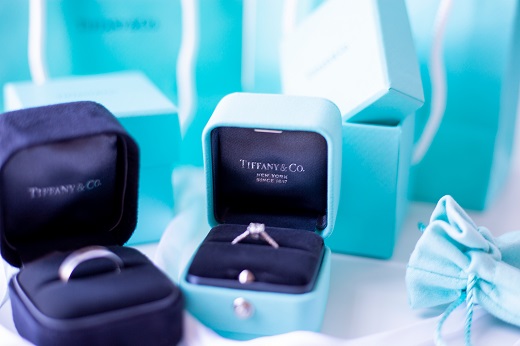|
|
LVMH Sees Value in Tiffany’s Diamond Sourcing
Nov 28, 2019 5:27 AM
By Joshua Freedman
|
|
|

RAPAPORT... A storied past and popularity as a brand might be
the first things that would attract a potential suitor to Tiffany & Co. But
LVMH has identified another key attribute that made the US jeweler a valuable
target: its ability to source its own diamonds and track its supply chain.
“Tiffany is [advanced], due to its very high level of
vertical integration, compared to our own brands,” said Jean-Jacques Guiony, LVMH’s
chief financial officer, in a conference call with analysts Tuesday. “We intend
to capitalize on that and create synergies, and we are sure value can be
extracted from combining the two business models in the group.”
Tiffany buys between 80% and 90% of its polished diamonds above
0.18 carats from mines as rough, and cuts them in-house, its CEO, Alessandro Bogliolo, said in a video interview with Bloomberg earlier this month. Laurelton Diamonds, Tiffany’s wholly owned manufacturing subsidiary, has long-term rough supply agreements with De Beers, Alrosa, Dominion Diamond Mines and Rio Tinto.
“It's opposite to the industry and other jewelers, which buy diamonds from the wholesale market,” Bogliolo added. “This…is very
relevant for a millennial consumer. First of all, [a consumer will] go to Tiffany
because they have the expertise.... The second point is that as we buy from the source, we can tell you where your diamond comes from.”
Tiffany sources more of its own goods than
LVMH’s jewelry businesses do, Guiony noted on a call it held following its
announcement that it was acquiring the New York retailer for $16.2 billion. Such
a sourcing and manufacturing strategy is a “unique asset” that could work to
the benefit of LVMH’s existing brands, and the French luxury group has no
intention of changing the model, he added.
“Tiffany is a very big player in all sorts
of diamonds, and it’s something where the sourcing is not easy to do, and we
expect to benefit from that,” he told listeners, without expanding on how it would achieve this.
Room to grow
The acquisition will increase
LVMH’s jewelry-and-watch sales to 16% of total revenue from 9%. While Tiffany has seen mixed results in recent years, LVMH has consistently reported strong growth in its jewelry and watch sales, with revenue for the category increasing 8% to EUR 1.13 billion ($1.24 billion) in the three months ending September 30.
The constant attention that comes from being an
independently listed company with regular reporting obligations can make
progress difficult for Tiffany, Guiony said. LVMH is also publicly traded, but doesn’t publish
individual brands’ results.
“We will bring Tiffany time and capital, which is not
easy to achieve as a company that has to report on a quarterly basis,” Guiony added.
One of the jeweler’s most costly projects, the renovation
of its flagship Fifth Avenue store, received a strong endorsement from LVMH,
though the buyer also indicated it should have happened a while ago. Tiffany
has allocated up to 2% of its global sales on overhauling the crucial retail
location, expecting to complete it in 2021.
“Despite the
fact the flagship on Fifth Avenue was iconic, mostly due to the [1961] Blake
Edwards movie [Breakfast at Tiffany’s], it’s also something the brand
needs to invest in, and I think the plan they have is the right thing to do,
not to mention that it was probably overdue,” Guiony explained. “I sympathize with the difficulty
of taking the decision to refurbish a store of that size and importance, but at
some point you have to go for it.”
Carry the brand
LVMH hopes to increase Tiffany’s revenue per square
meter, or sales density, which is currently lower inside the US than outside.
But this will come primarily from strengthening the brand, Guiony noted. Tiffany is also underrepresented in Europe, where it could do a better job of attracting both locals and tourists, Guiony observed.
The executive was content with Tiffany’s unusual mix of
expensive engagement rings and lower-priced silver jewelry, both of which are
major categories for the company.
“The question is not the price at which we sell [the]
items, but whether such items carry the value of the brand,” he asserted.
“Silver for Tiffany…is entry price and allows people to enter the brand with a
few hundred dollars, and we have no problem whatsoever with this line.”
Meanwhile, the importance of collections was a key lesson
LVMH learned from its $5.2 billion acquisition of Bulgari in 2011, and one it
hoped to apply with Tiffany, Guiony noted. The significant expansion of
Bulgari’s share of sales from collections has boosted revenue and profit in
recent years, he explained.
“In this respect, Tiffany is well positioned, but we’ll
insist in the future on the importance of capitalizing on existing collections
and developing new ones,” he predicted.
Image: Tiffany & Co. jewelry. (Shutterstock)
|
|
|
|
|
|
|
|
|
|
Tags:
Alrosa, Breakfast at Tiffany’s, De Beers, Dominion Diamond Mines, fifth avenue, Jean-Jacques Guiony, Joshua Freedman, Laurelton Diamonds, LVMH, Rapaport News, Rio Tinto, Tiffany, Tiffany & CO.
|
|
|
|
|
|
|
|
|
|
|

|
|